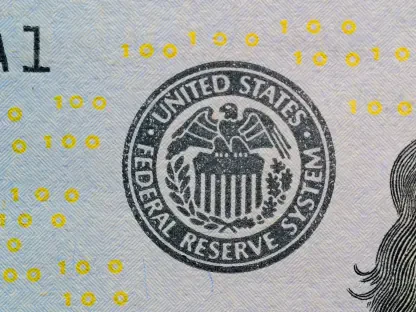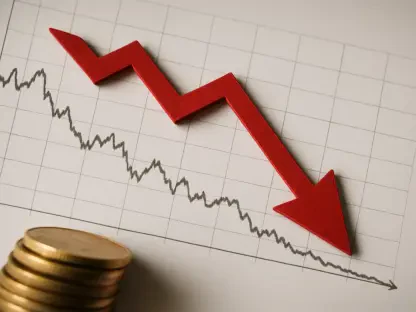In a financial landscape marked by anticipation and uncertainty, the Federal Reserve’s recent decision to maintain interest rates at a range of 4.25% to 4.5% during its July meeting has captured the attention of investors and analysts alike, who are keenly focused on future policy directions. This move, while widely anticipated, has not quelled the speculation surrounding a potential rate cut in September, a topic that dominates current market discourse. Fed Chair Jerome Powell’s cautious remarks during the post-decision press conference, highlighting that no firm plans have been set for the next meeting, have only deepened the ambiguity. Against a backdrop of robust economic indicators, mixed stock market reactions, and significant corporate earnings reports, the financial community finds itself at a crossroads. The strength of second-quarter GDP growth at 3% offers a positive signal, yet underlying concerns about economic cooling persist. Meanwhile, political pressures and looming trade policy decisions add further layers of complexity to an already intricate situation. This article aims to unpack the Federal Reserve’s latest policy stance, analyze the economic data shaping market sentiment, and explore the diverse reactions across sectors. It also delves into the corporate earnings landscape and the geopolitical factors influencing investor confidence. As the countdown to September begins, the interplay of these elements will undoubtedly shape the trajectory of the U.S. economy and financial markets in the coming months.
Monetary Policy and Market Expectations
The Federal Reserve’s choice to keep interest rates unchanged was met with little surprise, yet it revealed internal divisions that have sparked considerable discussion. Governors Christopher Waller and Michelle Bowman dissented, pushing for a quarter-point rate cut, a stance that underscores a broader debate within the Fed about the timing of monetary easing. Such disagreement highlights the challenge of balancing inflation control with the need to support economic growth in an environment of mixed signals. The decision to hold steady reflects a preference for caution, as policymakers await further data to guide their next steps. This internal split has not gone unnoticed by market participants, who are keenly aware that even small shifts in Fed sentiment could signal significant changes ahead.
Jerome Powell’s post-meeting statements added another dimension to the ongoing uncertainty. Emphasizing a data-driven approach, Powell made it clear that decisions for September remain undecided, with inflation and labor market reports expected to play a pivotal role. His measured tone suggests the Fed is not ready to commit to easing, despite market hopes for relief from high borrowing costs. This reticence has created palpable tension among investors, many of whom are factoring in a 63% probability of a rate cut in September based on current pricing. The gap between market expectations and the Fed’s non-committal posture continues to fuel volatility, as traders grapple with interpreting the central bank’s next move amidst a complex economic backdrop.
Economic DatSigns of Strength and Caution
Recent economic indicators released in tandem with the Fed’s decision paint a picture of resilience, though not without caveats. The second-quarter GDP growth rate of 3% annualized surpassed economist forecasts of 2.6%, signaling a robust recovery from the prior quarter’s contraction. The Bureau of Economic Analysis attributed this upswing in part to a reduction in imports, which had previously weighed on economic output. This headline figure has provided a boost to confidence, suggesting that the U.S. economy retains significant momentum despite global and domestic challenges. For many, this data serves as a counterpoint to concerns about slowdowns, offering a glimpse of stability in turbulent times.
However, beneath the surface of this impressive GDP number lie concerns that temper optimism. Analysts, including EY chief economist Gregory Daco, have warned that the growth might not reflect the full economic reality, pointing to volatile import data as a potential distortion. More telling are underlying metrics, such as sales to private domestic purchasers, which grew at a slower 1.2% rate in the second quarter compared to 1.9% previously. This slowdown hints at cooling activity that could undermine the headline strength if not addressed. Such disparities in the data underscore the need for a nuanced interpretation, as policymakers and investors alike seek to understand whether this growth trajectory is sustainable or merely a temporary uptick.
Adding to the narrative of economic health, private payroll data from ADP revealed a gain of 104,000 jobs in July, exceeding expectations of 77,000 and rebounding from June’s reported cuts. Nela Richardson, ADP’s chief economist, noted that this increase reflects growing employer optimism about consumer resilience, a critical factor in sustaining economic momentum. This labor market strength aligns with the positive GDP figures, reinforcing the perception of a healthy economy capable of weathering current uncertainties. Yet, questions remain about whether these gains can persist in the face of potential policy shifts or external pressures, keeping analysts vigilant for signs of fragility in the months ahead.
Stock Market Dynamics and Sectoral Shifts
The U.S. stock markets exhibited a varied response to the Fed’s rate decision and accompanying economic data, reflecting the broader uncertainty permeating the financial landscape. The Dow Jones Industrial Average fell by roughly 0.4%, indicative of cautious sentiment among investors wary of policy ambiguity. Meanwhile, the S&P 500 managed to recover from early losses, closing down a marginal 0.1%, while the tech-focused Nasdaq Composite posted a modest gain of 0.2%. These divergent outcomes highlight the uneven impact of current conditions across different sectors, with technology showing relative strength amid broader market hesitancy. The mixed performance serves as a reminder of how interconnected economic indicators and policy expectations are in shaping daily trading patterns.
After-hours trading provided further insight into sector-specific dynamics, particularly in technology, where standout earnings reports drove significant movements. Microsoft shares surged by 6% following a robust earnings release, with revenue reaching $76.4 billion and earnings per share surpassing consensus estimates. The company’s Intelligent Cloud segment, notably Azure, emerged as a key growth driver, underscoring the enduring appeal of cloud computing and AI innovations. Similarly, Meta Platforms saw its stock climb up to 10% after hours, fueled by earnings per share of $7.14 and revenue of $47.5 billion, both exceeding forecasts. Meta’s optimistic third-quarter guidance and focus on AI infrastructure investments further cemented the tech sector’s role as a market leader, even as other industries face headwinds.
Beyond the tech giants, other companies contributed to the diverse market narrative with their earnings results. Robinhood reported strong quarterly figures, with net revenue of $989 million and earnings per share of $0.42, driven by heightened trading activity amid market volatility. However, its stock wavered in after-hours trading, reflecting investor indecision despite substantial year-to-date gains. Hershey, on the other hand, saw its shares rise after beating second-quarter expectations, though it lowered full-year guidance due to soaring cocoa prices and tariff impacts. These varied outcomes across sectors illustrate the complex interplay of internal performance and external pressures, painting a fragmented picture of market health as investors navigate the current environment.
Corporate Earnings: Diverse Outcomes Across Industries
The broader corporate earnings season has revealed a patchwork of results, highlighting both resilience and vulnerability across different industries. In the tech sector, beyond Microsoft and Meta, companies like Reddit saw shares rise over 2% ahead of second-quarter earnings, buoyed by stabilizing user growth and AI-driven advertising tools. Analysts remain optimistic about Reddit’s trajectory, viewing its innovations as a potential catalyst for sustained gains. Meanwhile, Palo Alto Networks garnered attention with reports of advanced talks to acquire CyberArk for over $20 billion, a move that could mark one of the largest tech deals of the year. Such developments underscore the tech industry’s ongoing consolidation and investment in cybersecurity, reflecting a strategic focus on future growth amid competitive pressures.
Contrasting with tech’s strength, other sectors faced notable challenges in their earnings reports, revealing the uneven impact of economic conditions. Novo Nordisk experienced a 4% decline in premarket trading after lowering guidance for its diabetes and weight-loss drugs, a setback compounded by prior day losses. Conversely, V.F. Corp, the parent company of Vans, surged nearly 20% after surpassing revenue estimates, driven by strong demand for apparel and footwear. Starbucks also saw a 5% premarket gain despite reporting a sixth consecutive quarterly sales decline, as results were less severe than anticipated and leadership signaled progress in turnaround efforts. These disparate performances across consumer goods, healthcare, and retail sectors highlight the varied headwinds and opportunities companies face, shaped by both market trends and specific operational challenges.
Political and Trade Policy Pressures
Political dynamics have introduced an additional layer of complexity to the economic and market outlook, with direct implications for Federal Reserve policy. President Trump has publicly urged the Fed to lower interest rates, leveraging recent positive GDP data to argue for immediate action. Through social media and official statements, the administration has pressed for cuts to address inflation and ease borrowing costs for consumers. White House Press Secretary Karoline Leavitt echoed this sentiment, asserting that there are no remaining excuses for delaying rate reductions. This overt political pressure on a traditionally independent institution raises questions about the potential influence on monetary policy decisions, adding an element of unpredictability for markets already grappling with uncertainty.
Trade policy developments further complicate the landscape, with looming deadlines and negotiations poised to impact economic stability. A Friday deadline set by the administration for trade partners to finalize agreements with the U.S. has heightened tensions, with goods from India potentially facing a 25% tariff if no deal is reached. U.S.-China trade talks have concluded without an extension of the current tariff pause, though Treasury Secretary Scott Bessent indicated a final decision is imminent. Jerome Powell acknowledged the fluid nature of these negotiations, noting that the effective U.S. tariff rate might stabilize around 15%, though significant unknowns persist regarding their broader economic effects. Such uncertainties around trade policies contribute to a cautious market sentiment, as investors and policymakers alike struggle to anticipate the fallout from potential tariff hikes.
Looking Ahead: Navigating Uncertainty
Reflecting on the events surrounding the Federal Reserve’s decision to hold rates steady, it became evident that the financial markets stood at a critical juncture. The internal dissent within the Fed, coupled with Jerome Powell’s measured stance on future policy moves, left a lingering sense of ambiguity that shaped investor behavior throughout the period. Strong economic data, including a 3% GDP growth rate and solid job gains, provided a foundation of confidence, yet underlying concerns about cooling activity tempered the optimism that initially prevailed. The mixed performance of major stock indices, with tech-driven gains in the Nasdaq contrasting with declines in the Dow, captured the fragmented nature of market sentiment at that time.
Corporate earnings added further nuance to the narrative, as technology giants like Microsoft and Meta outperformed expectations, while other sectors grappled with cost pressures and policy impacts. Political rhetoric and unresolved trade negotiations introduced additional layers of risk, challenging the Fed’s independence and complicating economic forecasts. As attention turned to the future, the path forward demanded careful monitoring of inflation and labor market data, alongside vigilance for shifts in trade policy outcomes. Stakeholders across the spectrum were encouraged to prepare for multiple scenarios, ensuring adaptability in a landscape where resilience and uncertainty continued to coexist. The focus remained on leveraging incoming data to inform strategies, with the September meeting looming as a pivotal moment for clarity and direction.









